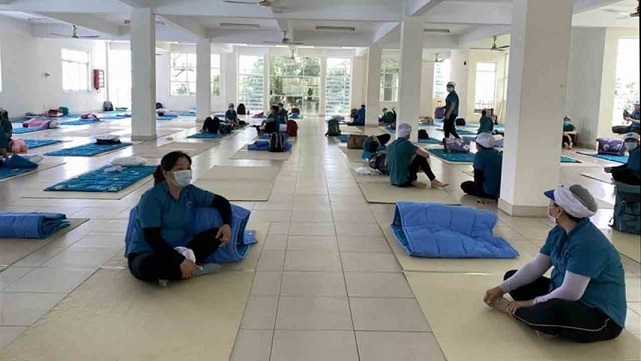 |
|
|
Tien Giang still requires enterprises to comply with the stay-at-work and one-route-two-destination mandates. The stay-at-work mandate forces workers to stay at the factories after work while the one-route-two-destination mandate requires employers to make accommodation arrangements outside factory for their workers and arrange buses for their workers to shuttle between place of accommodation and factory on a designated route.
According to these enterprises, more than 80% of their employees have already received one Covid-19 vaccine shot but they are still disallowed to return to work, the local media reported.
The province will allow enterprises to resume operations only if all their workers and their family members get fully vaccinated.
On October 1, these firms wrote to the chairperson of the province but have yet to receive any response or see any changes in regulations.
Tien Giang is still considering the stay-at-work mode as the centric solution for enterprises, in addition to stricter testing requirements than those of the Ministry of Health, causing difficulties for laborers and draining the resources of enterprises.
One of the 19 firms said that the stay-at-work and one-route-two-destination mandates were suitable for enterprises with a small number of employees. Those with thousands of workers cannot apply the mandates.
Despite suspending operations for over three months, they had to pay the salaries of workers, and are finding it hard to continue shouldering the costs. Moreover, 85% of orders have been shifted to other countries.
Apparel and footwear products cannot be kept long as they will lag behind the trends, so enterprises in these sectors must resume their operations quickly.
They do not expect to immediately reopen at a 100% capacity but will reopen step-by-step.
According to the 19 enterprises, Tien Giang’s regulations have put enterprises and laborers at a disadvantage. Over the past three months, most workers of enterprises experienced hard days and the disruption of supply chains.
They said they no longer had confidence in the province.
Therefore, they need the Government to come up with solutions to help them complete orders and save materials left unused for months.
These enterprises proposed the prime minister ask Tien Giang not to impose the stay-at-work and one-route-two-destination modes on enterprises.
In addition, laborers living in low-, moderate- and high-risk areas and having received at least one vaccine dose for 14 days should be allowed to return to factories early next month, using their personal vehicles or the enterprises’ vehicles.
They also suggested not extending the requirement that residents must not venture out between 7 p.m. and 5 a.m. to facilitate laborers to travel to factories for work.
Enterprises should be allowed to conduct quick tests, not real-time PCR tests, on laborers on the first day they return to work. Enterprises will later conduct tests weekly in line with the regulations of the Ministry of Health.
These firms also proposed allowing workers living in other localities to return to Tien Giang to work if they have been fully vaccinated against Covid-19.
Since July 15, most enterprises in Tien Giang have suspended their operations to fight the pandemic.
At a press briefing on October 21, Nguyen Nhat Truong, head of the Tien Giang Industrial Zone Authority, said many workers had yet to be aware of the danger of the highly catagious Delta variant, so the pandemic had broken out in 10 enterprises in the province. After August 5, the province stopped applying the stay-at-work mandate but later reinstate it.
At the time making this decision, the vaccination rate on workers was only 45%. The province could not put the health of workers and the community at risk as the pandemic resurgence is high.
At present, the vaccination rate has been higher but workers have received the vaccines for less than 14 days, Truong added.
Chau Thi My Phuong, head of the provincial Party Committee’s Board for Propaganda and Education, said besides the stay-at-work and one route-two destination mode, the province has combined the two modes and applied the green-green mode, in which workers from low-risk areas can come to factories in low-risk areas.
Source: Saigon Times